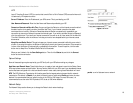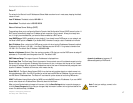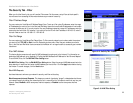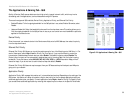
24
Chapter 5: Configuring the Router
The Security Tab - VPN
EtherFast Cable/DSL Router with 4-Port Switch
The Security Tab - VPN
The VPN screen allows you to allow VPN tunnels using IPSec, PPPoE, or PPTP protocols to pass through the
Router.
VPN Passthrough
IPSec Passthrough. IPSec (Internet Protocol Security) is a suite of protocols used to implement secure exchange
of packets at the IP layer. To allow IPSec Passthrough, click the Enabled button. To disable IPSec Passthrough,
click the Disabled button.
PPPoE Passthrough. PPPoE (Point-to-Point over Ethernet) Passthrough allows your PC(s) to use the PPPoE client
software provided by your ISP. Some ISPs may request that you use this feature on the Router. To allow PPPoE
Passthrough, click the Enabled button. To disable PPPoE Passthrough, click the Disabled button.
PPTP Passthrough. PPTP (Point-to-Point Tunneling Protocol) Passthrough allows the Point-to-Point (PPP) to be
tunneled through an IP network. To allow PPTP Passthrough, click the Enabled button. To disable PPTP
Passthrough, click the Disabled button.
When you have finished making changes to this screen, click the Save Settings button to save the changes, or
click the Cancel Changes button to undo your changes. Help information is shown on the right-hand side of the
screen.
Figure 5-17: Security Tab - VPN Passthrough
ipsec (internet protocol security): a VPN
protocol used to implement secure exchange
of packets at the IP layer
pptp (point-to-point tunneling protocol): a VPN
protocol that allows the Point to Point Protocol (PPP)
to be tunneled through an IP network. This protocol is
also used as a type of broadband connection in
Europe.
vpn (virtual private network): a security measure to
protect data as it leaves one network and goes to
another over the Internet


















